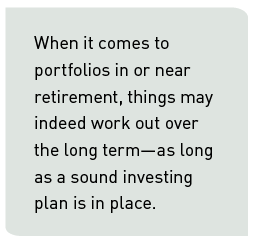HOME | ABOUT US | MEDIA KIT | CONTACT US | INQUIRE
HOME | ABOUT US | MEDIA KIT | CONTACT US | INQUIRE

For investors who are in or near retirement, the current market conditions present a unique set of challenges in portfolio management. After several years of robust equity returns coming out of the financial crisis, we have entered a period of heightened volatility, with the S&P 500 enduring two 10 percent corrections in the past six months. Many analysts and money managers have slashed their intermediate and long-term capital-markets expectations as a result of current valuations and economic forecasts. To make matters worse, those seeking to simply generate steady returns from a bond portfolio continue to face historically low interest rates. The most recent “flight to safety” has again pushed the 10-year treasury yield below 2 percent—an unrealistic income level for most retirees to live on.
 So what can retirement investors do when faced with sluggish equity growth and historically low interest rates? Unfortunately, there is no simple answer to this question. Many advisers recommend an equity exposure range between 40 and 50 percent in retirement, with the balance of the portfolio to be invested in various fixed-income instruments. Several adjustments could be made to this baseline allocation in efforts to generate a higher return, but doing so could cause investors to unknowingly take on substantial risk.
So what can retirement investors do when faced with sluggish equity growth and historically low interest rates? Unfortunately, there is no simple answer to this question. Many advisers recommend an equity exposure range between 40 and 50 percent in retirement, with the balance of the portfolio to be invested in various fixed-income instruments. Several adjustments could be made to this baseline allocation in efforts to generate a higher return, but doing so could cause investors to unknowingly take on substantial risk.
Tilt the allocation too far toward stocks and you risk excessive drawdown, which can quickly turn a 4 percent withdrawal (often considered a “safe” rate) into a 5 or 6 percent withdrawal if not managed carefully. Try to squeeze out higher interest rates from your bond portfolio by committing to longer maturities, and you face the considerable risk of market value losses if interest rates trend back upward. Keep your duration short but accept lower credit quality, and you face greater possibilities of default in an economic slowdown. Forget about the stock and bond markets and just move to cash, and you will be forced to quickly eat into principal, reducing your future spending power.
Though we are certainly in a challenging environment, investors have several practical options for improving their chances of success.
Maintain a Cash Buffer. Most planning experts agree that while an individual is working, an emergency savings account should be maintained with six to 12 months of expenses set aside just in case that person were to become injured or otherwise unable to work, experience a layoff, etc. In retirement, we become dependent on our investment portfolio to do the heavy lifting for us, as it essentially goes to work every day on our behalf. Why not provide the same safety net here, just in case that portfolio becomes “injured” or temporarily unable to produce the income that we expect? Maintaining a healthy cash buffer allows an investor to refrain from liquidating assets or dipping too far into principal during times of market turmoil.
Diversify Sources of Income or Return. While the principles of diversification apply to investors at all stages, retirees in particular should not become overly dependent on any one income source or asset class. Consider preferred equity, closed-end funds, real estate, and other diversifying portfolio exposures in addition to the traditional dividend-paying equities and corporate/government bonds that comprise most retirement allocations. Layering in asset classes that aren’t as closely correlated with one another can help to smooth return patterns over time.
Avoid the Paralysis of Fear. Sensationalist media headlines vying for attention tend to create more fear and doubt for investors, often leading to irrational portfolio decisions. An article titled “Dow to drop 45 percent this year, pundit says” will garner far more attention than something along the lines of “Things will generally work themselves out over the long term.” A disciplined, consistent approach is far more likely to generate a positive retirement outcome than a strategy that changes radically, based on the most recent headlines. Investing can be an extremely emotional experience, especially when dealing with an individual’s life savings. A well-designed plan, whether crafted individually or with the help of a professional, allows an investor to follow protocol during every stage of a market cycle rather than attempting to make judgment calls on the fly during times of turbulence.
Though there are undeniable hurdles in today’s investing environment, it’s important to remember that for most, retirement is a long journey spanning multiple stock-market cycles, election years, periods of global uncertainty and, ultimately, patterns of return for portfolios. Though it may be cliché to suggest, the underlying logic here is that “things will generally work themselves out over the long term”—as long as a sound plan is in place.